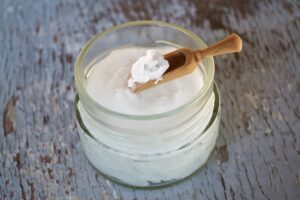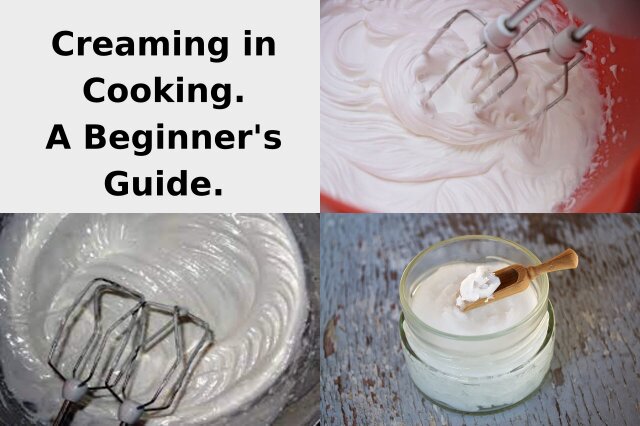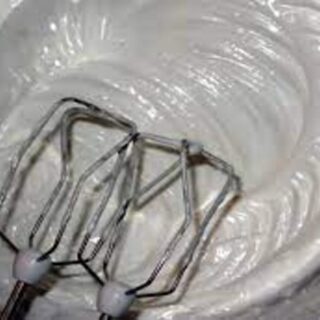Creaming is a fundamental technique in cooking that involves combining butter and sugar together until light and fluffy.
This process creates a smooth and airy texture, which is essential for many baked goods like cakes, cookies, and frostings.
In this guide, we will explore the definition of creaming and provide you with step-by-step instructions to achieve perfect creaming in your recipes.
What is creaming in cooking?
 Creaming in cooking refers to the process of combining butter and sugar together until light and fluffy.
Creaming in cooking refers to the process of combining butter and sugar together until light and fluffy.
This technique is commonly used in baking to create a smooth and airy texture in baked goods.
Creaming helps to incorporate air into the mixture, resulting in a lighter and more tender final product.
It is an essential step in making cakes, cookies, and frostings.
By creaming the butter and sugar together, you are creating a base that will provide structure and flavour to your baked goods.
The importance of creaming in baking.
Creaming is an important technique in baking that can greatly impact the texture and flavour of your baked goods.
When butter and sugar are creamed together, the sugar crystals help to aerate the butter, creating tiny pockets of air.
This incorporation of air helps to give your baked goods a light and fluffy texture.
Additionally, creaming also helps to dissolve the sugar, resulting in a smoother and more even distribution throughout the batter.
The process of creaming also helps to create a base that will provide structure and stability to your baked goods.
Overall, mastering the art of creaming in baking is essential for achieving delicious and professional-quality results.
What equipment is used for Creaming in Cooking?
There are various pieces of equipment that can be used for creaming in cooking, ranging from stand mixers and hand mixers to food processors and blenders.
Whisks, rubber spatulas, and immersion blenders are also essential tools for achieving a creamy texture.
The choice of equipment depends on the specific recipe and the desired consistency of the creamed ingredients.
- Stand Mixer;
- Hand Mixer;
- Food Processor;
- Blender;
- Whisk;
- Rubber Spatula;
- Immersion Blender;
A stand mixer is a versatile piece of equipment that is commonly used for creaming in cooking.
It has a powerful motor and various attachments, such as a paddle or whisk, that can be used to mix ingredients together and create a creamy texture.
Stand mixers are especially useful when making desserts like cakes, cookies, and frostings.
A hand mixer is a handheld appliance that is also commonly used for creaming in baking.
It is smaller and more portable than a stand mixer, making it convenient for smaller batches or when you don’t have access to a stand mixer.
Hand mixers usually come with different speed settings and attachments, such as beaters or dough hooks, to help achieve the desired creamy consistency.
A food processor is another useful tool for creaming in cooking.
While it is primarily used for chopping, slicing, and pureeing ingredients, it can also be used to cream certain ingredients together.
By pulsing the ingredients in the food processor, you can achieve a creamy texture without the need for a mixer.
Blenders are commonly used for making smoothies and purees, but they can also be used for creaming in cooking. By blending ingredients together at high speeds, blenders can create a smooth and creamy consistency. They are particularly useful for creaming soups, sauces, and dressings.
While not a piece of equipment per se, a whisk is an essential tool for creaming when baking.
It is used to manually mix and incorporate ingredients together, creating a creamy texture. Whisks come in various sizes and shapes, such as balloon whisks or flat whisks, and can be used for both small and large batches.
A rubber spatula is a handy tool for scraping down the sides of bowls and ensuring all ingredients are properly mixed together.
It is especially useful when creaming ingredients that tend to stick to the sides of the mixing bowl, such as butter or cream cheese.
Rubber spatulas are gentle on the ingredients and help achieve a smooth and creamy consistency.
An immersion blender, also known as a hand blender, is a handheld appliance that can be used for creaming in cooking.
It consists of a blending wand with a rotating blade at the end. Immersion blenders are particularly useful for creaming soups and sauces directly in the pot or container, eliminating the need to transfer the mixture to a separate appliance.
Step-by-step guide to creaming butter and sugar.
With practice and attention to detail, you will be able to achieve perfect creaming in your baking and create delicious treats.
Ingredients
- 1 cup diced butter
- 1 cup sugar
Instructions
- Start with softened butter:
Before you begin creaming the butter and sugar, make sure your butter is at room temperature.
This will ensure that it is soft enough to easily mix with the sugar. - Measure the ingredients:
Measure out the desired amount of butter and sugar.
The general rule of thumb is to use equal parts butter and sugar, but you can adjust the ratio based on your preference. - Place the butter in a mixing bowl:
Transfer the softened butter into a mixing bowl.
It's best to use a bowl with high sides to prevent any splattering. - Beat the butter:
Using an electric mixer or a stand mixer fitted with a paddle attachment, beat the butter on medium speed until it becomes smooth and creamy.
This usually takes about 2-3 minutes. - Add the sugar gradually:
Gradually add the sugar to the creamed butter, about 1/4 cup at a time.
Continue beating on medium speed until the sugar is fully incorporated and the mixture becomes light and fluffy.
This process usually takes around 3-4 minutes. - Scrape down the sides of the bowl:
Pause the mixer and use a spatula to scrape down the sides of the bowl.
This will ensure that all the butter and sugar are evenly mixed. - Continue beating:
Resume beating the mixture on medium speed for another 1-2 minutes.
This will further incorporate the butter and sugar, resulting in a smooth and creamy texture. - Test the consistency:
To check if the butter and sugar are properly creamed, take a small amount between your fingers and rub them together.
It should feel smooth and not grainy. - Use as desired:
Once the butter and sugar are creamed to perfection, you can use it in various recipes.
It is commonly used as a base for cakes, cookies, frostings, and other baked goods. - Store leftovers:
If you have any leftover creamed butter and sugar, you can store it in an airtight container in the refrigerator for up to a week.
Just make sure to bring it back to room temperature before using it in your next recipe.
Notes
Tips for achieving the perfect texture in creamed mixtures.
Achieving the perfect texture in creamed mixtures is essential for creating delicious baked goods. Here are some tips to help you achieve that perfect texture. By following these tips, you can achieve the perfect texture in your creamed mixtures, resulting in delicious and beautifully textured baked goods.- Use room temperature ingredients:
When making creamed mixtures, it is important to use ingredients that are at room temperature.
This allows the ingredients to blend together more easily and creates a smoother texture. - Start with softened butter:
Softened butter is easier to cream with sugar and other ingredients.
Leave the butter at room temperature for about 30 minutes before using it in your recipe. - Cream the butter and sugar properly:
Creaming butter and sugar together is a crucial step in achieving the perfect texture.
Use an electric mixer to beat the butter and sugar until light and fluffy. This process incorporates air into the mixture, resulting in a lighter texture. - Gradually add ingredients:
When adding other ingredients, such as eggs or flour, it is important to do so gradually.
Adding them all at once can result in a dense and heavy texture. Add the ingredients in small increments, mixing well after each addition. - Use the right mixing technique:
When mixing the ingredients, use a gentle folding or stirring motion.
Overmixing can lead to a tough texture. Mix just until the ingredients are combined and no streaks remain. - Use the right tools:
Using the right tools can make a big difference in achieving the perfect texture. Use a stand mixer or hand mixer for creaming the butter and sugar, and a spatula or wooden spoon for folding in other ingredients. - Chill the mixture if needed:
If the mixture becomes too soft or sticky, it may benefit from a short stint in the refrigerator.
Chilling the mixture can help firm it up and make it easier to work with.
Common mistakes to avoid when creaming in cooking.
While creaming in cooking may seem simple, there are some common mistakes that can result in less than perfect results.- Over-creaming the butter and sugar:
One of the most common mistakes when creaming in cooking is over-creaming the butter and sugar.
Over-creaming can lead to a dense and dry final product. It is important to cream the butter and sugar just until they are combined and light and fluffy, as over-creaming can cause the mixture to become too airy and result in a less desirable texture. - Using cold ingredients:
Another mistake to avoid when creaming in cooking is using cold ingredients.
Cold butter and eggs can prevent proper creaming and result in a lumpy mixture. It is important to ensure that all ingredients, especially the butter and eggs, are at room temperature before starting the creaming process.
This will allow for easier incorporation and a smoother texture. - Not scraping down the sides of the bowl:
Scraping down the sides of the bowl is an important step that is often overlooked when creaming in cooking.
Not scraping down the sides of the bowl can result in uneven mixing and leave pockets of unmixed ingredients. To ensure a uniform mixture, it is important to periodically stop and scrape down the sides of the bowl with a spatula to incorporate any ingredients that may have stuck to the sides. - Over-mixing the batter:
Over-mixing the batter is another common mistake when creaming in cooking.
Over-mixing can lead to a tough and dense final product. It is important to mix the batter just until the ingredients are combined and no streaks of flour remain.
Over-mixing can develop the gluten in the flour, resulting in a less tender texture. - Adding too much flour at once:
Adding too much flour at once is a mistake that can lead to a dry and crumbly final product.
It is important to add the flour gradually, mixing it in just until it is incorporated. This will help prevent over-mixing and ensure a moist and tender texture. - Not properly measuring ingredients:
Not properly measuring ingredients is a mistake that can throw off the balance of the recipe and result in an undesirable outcome.
It is important to use measuring cups and spoons to accurately measure the ingredients. Using too much or too little of an ingredient can affect the texture and flavour of the final product. - Ignoring the recipe instructions:
Ignoring the recipe instructions is a mistake that can lead to a failed creaming process.
Each recipe may have specific instructions for creaming, such as the order in which ingredients should be added or the recommended mixing time. It is important to carefully read and follow the recipe instructions to ensure the best results.
FAQ
Why is creaming important?
Creaming is important because it helps to create air bubbles in the batter or dough.These air bubbles help to lighten the baked good and give it a more tender texture.
Without creaming, baked goods would be denser and less flavourful.
What are the benefits of creaming?
Creaming offers several benefits, including:Lighter, more tender baked goods, increased volume, Improved flavour and makes it easier to mix other ingredients into the batter or dough.
What are the risks of not creaming?
If you do not cream the butter and sugar properly, your baked goods may be:Dense, tough, lacking in flavour and not as light and fluffy.
How long should I cream the butter and sugar?
The amount of time you need to cream the butter and sugar will vary depending on the recipe.However, a good rule of thumb is to cream them until the mixture is light and fluffy and has doubled in volume.
You can test this by scraping the batter or dough off the spatula and letting it fall back into the bowl.
If it falls back slowly, it is ready. If it falls back quickly, it needs to be creamed for a little longer.
What can I use instead of butter for creaming?
You can use other fats, such as shortening or margarine, instead of butter for creaming.However, keep in mind that the flavour and texture of your baked goods may be different.
What can I do if I overcream the butter and sugar?
If you accidentally overcream the butter and sugar in a recipe, there are a few things you can do to fix it.One option is to add a tablespoon or two of flour to the mixture to help absorb some of the excess moisture.
Another option is to refrigerate the dough for about 30 minutes to firm it up before continuing with the recipe.
You can also try adding a small amount of liquid, such as milk or water, to help balance out the texture.

